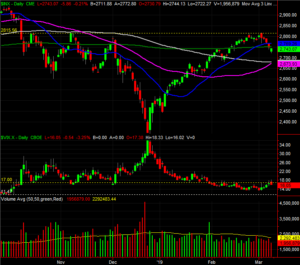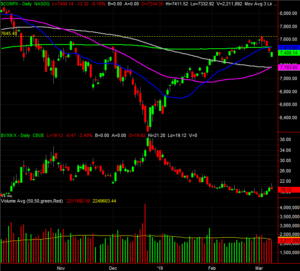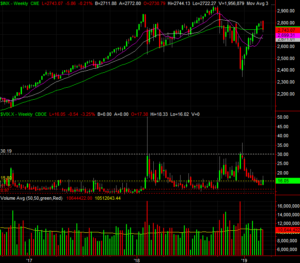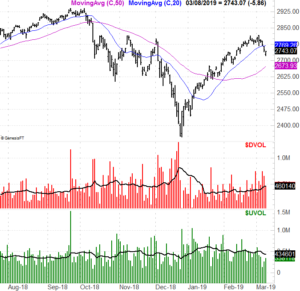Price Headley’s Weekly Market Outlook, March 11th, 2019 – Stuck in the Middle with You
Five straight days of losses for the S&P 500 certainly forces traders to rethink how strong this market really is. Yet, even as Friday’s action was winding down, the bulls were testing the waters again, with the market never really slipping into too much trouble
On the other hand, even with Friday’s intraday reversal effort, stocks were able to move to the proverbial wrong side of the fence.
In retrospect, the 2815 area is a real problem for the S&P 500. The index topped out there in October and November, and then failed to move above that line with last week’s effort. End result? The index is now back below a couple of key moving average lines, including the key 200-day moving average line (green).
S&P 500 Daily Chart, with Volume

Source: TradeStation
But Friday ended on a high note? Yes, it did, which on the surface may be encouraging. There’s a lot of psychology going on right now though, and it’s actually a double-edged sword.
A bad start and even worse finish on Friday could have been considered a capitulation of sorts… particularly if it was a high-volume affair. Instead we got a bad start and an intraday bounceback, and saw it unfurl on low volume. It may have been nothing more than a respite from a selling effort that will get going in earnest again this week. Traders haven’t yet suffered that spike in fear that tends to accompany a good, long-lasting bottom.
Same basic story for the NASDAQ Composite – the cross above the 200-day moving average line last month was impressive, but as soon as the October/November highs were met, the effort faded.
NASDAQ Composite Daily Chart, with Volume

Source: TradeStation
Both indices are now in a proverbial no-man’s land, below the 20-day and 200-day moving averages, but above the 50-day (purple) and 100-day (gray) moving average lines. The market could easily bounce around between that floor and ceiling for a while, never making any net progress. The real action will be outside of those boundaries.
Still, despite Friday’s intraday rebound, the tide is bearish.
Zoom out to the weekly chart of the S&P 500 for a moment. Last week’s 2.1% tumble is survivable, but the past two major setbacks from October and even as far back as February of last year got started with big jolts. The recent mindset has been once it starts to rain, traders tend to make it pour.
S&P 500 Weekly Chart, with Volume

Source: TradeStation
You can also see on the weekly chart the VIX is miles away from a peak level that tends to coincide with market bottoms.
It’s a conundrum. Though there are decent bullish and bearish arguments to be made, the big driving force right now is sentiment, which is ultimately driven by politics. The right news on the right day can send stocks soaring, while the wrong news on the wrong day could prove devastating. We could use conventional interpretation of charts to glean some sort of picture about what’s in store, but it would be of little value. They’re even of less value as long as the index is trapped between all of its key moving averages.
What we’re really watching right now is the VIX, and volume, as the simple look at the indices can be somewhat deceptive.
If the VIX pushes above the ceiling at 18.0 and the S&P 500 moves to lower lows, that’s trouble… though bear in mind the convergence of the 50-day and 100-day moving average lines at 2674 could turn into at least temporary support.
And, if the market starts to lose ground on rising volume – something we’ve somewhat seen, but not seen in earnest – that too is trouble. On the flipside, if bullish volume starts to flow again (something we’ve definitely NOT seen of late) and the S&P 500 can push its way back above the 20-day and 200-day moving average lines, that’s a buy signal too. The NYSE’s up-volume and down-volume data on the bottom portion of the chart below illustrates how and why it was only a matter of time before the rug got pulled out from underneath the market last week.
S&P 500 Daily Chart with NYSE Up, Down Volume

Source: TradeNavigator
The hardest part is the waiting, for one side or the other to flinch. But, waiting is the smart-money move here.







